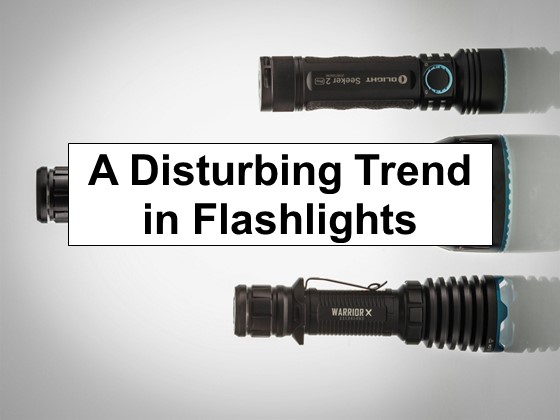This past weekend, our young cat climbed an enormous tree in our backyard which had a nearly vertical split trunk. She was up at least twenty-five or thirty feet, which meant climbing a ladder to get her was out of the question. Of course, she waited until about dark to perform her stunt, which meant we were out there after dark for an hour two trying to get her down. We tried everything we could think of. Eventually, she shimmied her way down backwards, which was both relieving because there are many predators out at night, but annoying because she could’ve just done that earlier.
At some point, we had three or four flashlights out there and a lantern. But we (and by “we” I mean other people) misplaced one of my flashlights after the ordeal. I’m sure I’ll find it at some point, but I don’t like being without, and I don’t mind a manufactured reason to purchase a new flashlight now and again.
So, I started browsing Amazon for LED flashlights. And that’s when I noticed a disturbing trend: more and more flashlights are rechargeable. Very few offerings, in fact, showed as using batteries. Thus, I refined my search for “AA LED flashlight” and, although there were more choices, many flashlights still showed as being rechargeable.
I see this as a problem. Why? Because it means that, like it or not, at some point we’re going to be forced to use flashlights that are only rechargeable. While not a problem when times are good, this trend could become a problem during a SHTF event when recharging capabilities are limited or nonexistent. Granted, it’s not like all battery-powered flashlights are going to disappear overnight, but there is an obvious trend, and the trend isn’t good from a survival perspective.
I’m also not saying you should go out and stockpile battery-powered flashlights right now. But you should have something available. And if you’ve purchased LED flashlights, like I have in the past, then have some capability of recharging them should something happen. Usually, that means a small solar setup. Heck, even some gasoline to keep your car running is enough to allow you to recharge equipment (phones, flashlights, power banks) while also using a power inverter to run bigger items, like refrigerators during a short-term outage.
Of course, it’s not only flashlights. I’ve noticed this trend in LED headlamps and to a lesser extent in LED lanterns. It’s becoming increasingly difficult to find a personal fan that isn’t rechargeable.
Ultimately, I’d say the writing is on the wall. At some point, gear that uses replaceable batteries will go the way of the wall phone, cassette tapes … and disco. 🙂
Plan accordingly.

Leave a Reply